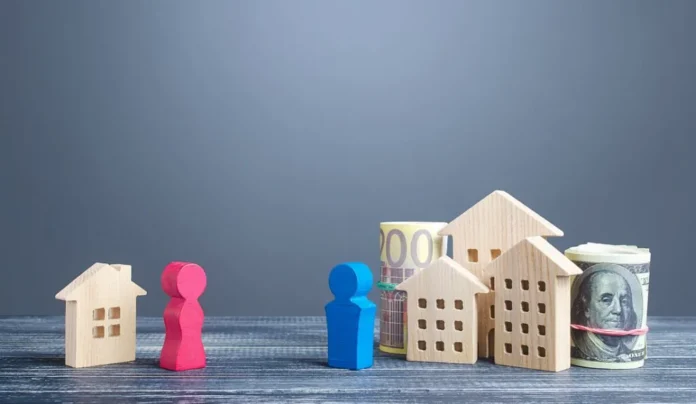
When considering a new home purchase, options like tract homes, spec homes, custom homes, or semi-custom homes come to mind.
A spec house, designed and constructed without a specific buyer, offers a move-in-ready home with desirable features and the latest design trends. Their construction aligns with higher standards in desirable neighbourhoods, including high-end finishes.
If you’re seeking a new home but feel overwhelmed by customization decisions, a spec house from reputable construction home builders could be a suitable choice.
Key Takeaways:
- Spec houses offer move-in-ready homes with desirable features and current design trends.
- They’re built to higher standards and located in desirable neighbourhoods.
- Excellent for buyers who prefer ready-made homes.
The Basics of Speculative Homes

Spec homes, or speculative homes, are new residences constructed by professional home builders. These homes stand on land that the builder intends to develop. With spec homes, buyers can purchase a new property without a lengthy construction process.
Builders include popular features in the residential real estate market, such as open layouts, kitchen islands, walk-in showers, granite countertops, and other trending elements. These homes are move-in ready and built according to high-grade specifications.
Costs of a Speculative Home
Spec houses are more affordable than custom-built homes, where every aspect aligns with the buyer’s preferences. However, spec homes are often more expensive than standard new construction homes offered by developers in the area due to their enhanced features and finishes.
The cost depends on several factors:
- Location
- Square Footage
- Design
- Amenities/Features
- Labour Costs
- Land Size
- Building Materials
Pros and Cons
Pros of spec houses:
- More affordable. Spec houses can provide a more affordable option and allow buyers to enjoy a luxurious home at a lower cost.
- No waiting. Spec houses are ready for immediate occupancy or close to it. There is no need to wait months or even years for the construction completion.
- Turnkey condition. Spec houses are move-in ready without renovations, repairs, or upgrades. Every feature and aspect of the house is fresh and new, providing convenience and saving time and effort.
Cons of spec houses:
- Limited control over location. One of the drawbacks of spec houses is that buyers need control over the place.
- Fewer customization choices. Designed with the builder’s vision, buyers have fewer customization options. Remodelling later would require additional expenses.
- Potential payment for unnecessary features. Since spec houses cannot be fully customized, buyers might pay for features they don’t want or need.
Exploring Single-Family and Multi-Family Investment Options

Single-Family Homes
A single-family home is a detached house with no shared walls, while others include attached dwellings like townhouses as long as they have a ground-to-roof wall separating them.
Also, single-family homes must have exclusive utility, heating, and air conditioning systems. They also have private entrances and exits, providing direct access to the street.
Multi-family Homes
A multifamily home has various housing units designed for separate households and equipped with individual features like kitchens, living rooms, utility bills, and patios. Custom home builders target densely populated areas, like cities, to meet the demand for housing in limited spaces.
Single-Family vs. Multi-Family
| Type | Single-Family Home | Multi-Family Home |
| Description | A detached house without shared walls. | Buildings that can house many different families at once. |
| Examples | Bungalow, cottage, or farmhouse. | Apartment or a condo building, a duplex, triplex or even a quadplex |
| Advantages |
|
|
| Disadvantages |
|
|
Conclusion

When considering speculative home investments, weighing various factors carefully to ensure a return on investment is important. Conduct thorough market research to look into the demand and potential appreciation in both the single-family and multi-family segments.
Also, considering the investment timeframe, risk tolerance, and personal financial goals will help determine which type of speculative home investment aligns best with individual needs.
Connect with a skilled team of construction home builders from Major Homes Ltd. today to bring your dream home to life and maximize your investment opportunities.
Frequently Asked Questions
How do I identify an excellent speculative home investment opportunity?
- Study the local real estate market for trends, demand, and growth areas.
- Consider pricing and sales data of similar properties to evaluate competitiveness and appreciation potential.
- Assess the property’s condition and decide if renovations align with market demand.
- Analyze purchase price, renovation costs, carrying costs, and potential returns on investment.
- Evaluate potential risks like market volatility, financing challenges, and regulatory changes—plan for contingencies.
How does speculative home investment differ from other types of real estate investing?
Speculative home investment is when you invest in a property hoping its value will increase quickly so you can sell it for a profit. This differs from investing in a property for a long time to make money from renting or improving it. However, this kind of investment usually means paying more fees, like when you buy or sell the property.
Can I live in one unit of a multi-family home and rent out the others?
Yes, you can live in one unit of a multi-family home and rent out the others. This arrangement is commonly known as “house hacking” and can be a financially advantageous strategy for homeowners.
House hacking involves purchasing a multi-family property and living in one of the units while renting out the remaining units to tenants. This approach allows you to have rental income that can offset your mortgage payments and other expenses associated with homeownership.
















